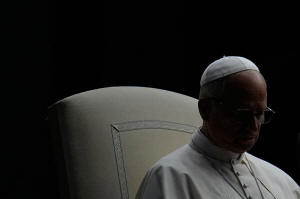Vatican report says clergy sex abuse victims need reparations and
tangible sanctions to heal
[October 16, 2025]
By NICOLE WINFIELD
VATICAN CITY (AP) — The Vatican’s child protection board said Thursday
the Catholic Church has a moral obligation to help victims of clergy
sexual abuse heal, and identified financial reparations and sanctions
for abusers and their enablers as essential remedies.
The Pontifical Commission for the Protection of Minors focused on the
issue of reparations in its second annual report. It’s an often
sensitive topic for the church, given the financial, reputational and
legal implications it imposes on the hierarchy.
The report was significant — an official Vatican publication prepared
with the input of 40 abuse survivors from around the world and giving
voice to their complaints of how badly the church had handled their
cases, and their demands of what they need to heal.
It said monetary settlements were necessary to provide victims with
needed therapy and other assistance to help them recover from the trauma
of their abuse.
But it said the church owed a debt far greater to victims, the broader
church community and God. The hierarchy must listen to victims and
provide them with spiritual and pastoral help. Church leaders must
apologize for the harm done, tell victims what they are doing to punish
those who harmed them and what measures they are taking to prevent
future abuse, the report said.
“The church bears a moral and spiritual obligation to heal the deep
wounds inflicted from sexual violence perpetrated, enabled, mishandled,
or covered up by anyone holding a position of authority in the church,”
it said.

Pope Leo signals commitment to commission
The report covers 2024, a period before Pope Leo XIV was elected.
History’s first American pope has acknowledged that the abuse scandal
remains a “crisis” for the church, and that victims need more than
financial reparations to heal.
He has signaled a commitment to the commission, which was created by
Pope Francis in 2014 to advise the church on best practices to prevent
abuse. In its first decade, the commission struggled to find its footing
in a Vatican often resistant to confronting the abuse crisis and hostile
to endorsing victim-focused policies.
But more recently, the commission has carved out its space in the
Vatican bureaucracy and in July Leo named a new president, French Bishop
Thibault Verny.
At a press conference launching the report, Verny said it was evidence
of the commission's belief that a culture of prevention in the church
requires the active involvement of victims.
The report itself was prepared with victims in a focus group setting who
listed priorities for their healing. They identified accountability for
church leaders, information about their cases, true reform of church
structures to adequately punish abusers and their enablers, and
effective prevention strategies.
“The commission is committed to saying to victims and survivors: ‘We
want to be by your side,’” Verny said.

[to top of second column]
|

Pope Leo XIV presides over a Rosary vigil for peace in St. Peter's
Square on the 63rd anniversary of the start of the Second Vatican
Council, at the Vatican, Saturday, Oct. 12, 2025. (AP Photo/Gregorio
Borgia)

A legal process that is itself retraumatizing
Significantly, the 2024 report said the church’s way of handling
abuse cases internally, according to a secretive process that
provides no tangible accountability, was itself retraumatizing for
victims.
“We must re-emphasise that the church’s decades-long pattern of
mishandling reports, including abandoning, ignoring, shaming,
blaming, and stigmatizing victims/survivors, perpetuates the trauma
as an ongoing harm,” it said.
It was a reference to the church’s dysfunctional way of dealing with
abuse cases according to its in-house canonical code, where the most
severe punishment meted out to a serial rapist priest amounts to
being fired.
The process is cloaked in secrecy, such that victims have no rights
to information about their case other than learning its outcome,
which often comes after a yearslong wait. Victims have no real
recourse other than going public with their story, which can be
retraumatizing.
The report called for sanctions that were “tangible and commensurate
with the severity of the crime.” While laicization is a possible
outcome for priests who rape children, the church is often loathe to
remove priests entirely. It frequently gives out lesser sanctions,
such as a period of retreat away from active ministry for even gross
cases of abuse.
Even when a bishop is removed for bungling cases, the public is only
told that he has retired. The report called for the church to
“clearly communicate reasons for resignation or removal.”

An audit of countries and Vatican office
The report provided an audit of child protection policies and
practices in over a dozen countries, as well as within two religious
orders, a lay movement and one Vatican office.
The report found that the Vatican’s missionary evangelization
office, which is responsible for the church in Africa, Asia and
parts of the developing world, has the resources to handle abuse
cases.
But it noted that only a “small number of cases” actually arrive in
Rome, suggesting the church in Africa and Asia remains decades
behind the West in reporting and handling abuse cases.
The report said the missionary office had only handled two cases of
bishops who mishandled abuse cases, a staggeringly low number given
the size of the territory involved.
Such data suggests the Vatican still has a long way to go in parts
of the world where abuse, especially same-sex abuse, remains a taboo
topic in the wider society and where the church is confronting
broader issues of war, conflict and poverty.
All contents © copyright 2025 Associated Press. All rights reserved |